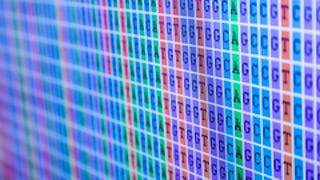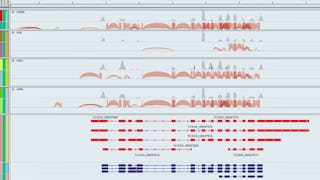Groß angelegte Biologieprojekte wie die Sequenzierung des menschlichen Genoms und Umfragen zur Genexpression mit Hilfe von RNA-seq, Microarrays und anderen Technologien haben eine Fülle von Daten für Biologen hervorgebracht. Die Herausforderung für die Wissenschaftler besteht jedoch darin, diese Daten zu analysieren und sogar darauf zuzugreifen, um nützliche Informationen über das untersuchte System zu gewinnen. Dieser Kurs konzentriert sich auf die Nutzung vorhandener bioinformatischer Ressourcen - hauptsächlich webbasierte Programme und Datenbanken -, um auf die Fülle von Daten zuzugreifen und Fragen zu beantworten, die für den durchschnittlichen Biologen relevant sind.

Genießen Sie unbegrenztes Wachstum mit einem Jahr Coursera Plus für 199 $ (regulär 399 $). Jetzt sparen.

Bioinformatische Methoden I
Dieser Kurs ist Teil von Spezialisierung für Bioinformatische Methoden für Pflanzen

Dozent: Nicholas James Provart
117.112 bereits angemeldet
Bei enthalten
(1,780 Bewertungen)
Kompetenzen, die Sie erwerben
- Kategorie: Datenanalyse
- Kategorie: Biowissenschaften
- Kategorie: Biostatistik
Wichtige Details

Zu Ihrem LinkedIn-Profil hinzufügen
9 Aufgaben
Erfahren Sie, wie Mitarbeiter führender Unternehmen gefragte Kompetenzen erwerben.

Erweitern Sie Ihre Fachkenntnisse
- Lernen Sie neue Konzepte von Branchenexperten
- Gewinnen Sie ein Grundverständnis bestimmter Themen oder Tools
- Erwerben Sie berufsrelevante Kompetenzen durch praktische Projekte
- Erwerben Sie ein Berufszertifikat zur Vorlage

In diesem Kurs gibt es 8 Module
In diesem Modul werden wir die erstaunlichen Ressourcen des NCBI, des National Centre for Biotechnology Information, das von der National Library of Medicine in den USA betrieben wird, erkunden. Wir werden auch eine Blast-Suche durchführen, um ähnliche Sequenzen in der riesigen NR-Sequenzdatenbank zu finden. Anhand ähnlicher Sequenzen können wir auf die Homologie schließen, die der wichtigste Prädiktor für die Funktion eines Gens oder Proteins ist.
Das ist alles enthalten
4 Videos4 Lektüren1 Aufgabe
In diesem Modul werden wir die unglaublichen Ressourcen des NCBI, des National Centre for Biotechnology Information, weiter erforschen. Wir werden mehrere verschiedene Arten von Blast-Suchen durchführen: BlastP, PSI-Blast und Translated Blast. Anhand ähnlicher Sequenzen, die mit diesen Methoden identifiziert werden, können wir auf die Homologie schließen, die der wichtigste Prädiktor für die Funktion eines Gens oder Proteins ist. Wir werden auch Teile der Genome einiger verschiedener Arten vergleichen, um zu sehen, wie ähnlich sie sich sind.
Das ist alles enthalten
4 Videos2 Lektüren1 Aufgabe
In diesem Modul werden wir multiple Sequenzalignments mit Clustal und MUSCLE (wie in MEGA implementiert) und MAFFT durchführen. Multiple Sequenzalignments können Ihnen sagen, wo in einer Sequenz die konservierten und variablen Regionen liegen, was für das Verständnis der Biologie der untersuchten Sequenzen wichtig ist. Es gibt auch praktische Anwendungen, wie z.B. die Möglichkeit, PCR-Primer zu entwerfen, die Sequenzen aus einer Reihe verschiedener Arten amplifizieren können.
Das ist alles enthalten
4 Videos2 Lektüren1 Aufgabe
Das ist alles enthalten
1 Aufgabe
In diesem Modul werden wir die multiplen Sequenzalignments verwenden, die wir im letzten Labor erstellt haben, um einige phylogenetische Analysen mit Nachbarschafts- und Maximum-Likelihood-Methoden durchzuführen. Die baumartige Struktur, die durch solche Analysen erzeugt wird, gibt Aufschluss darüber, wie eng die Sequenzen miteinander verwandt sind und wann im Laufe der Evolution eine Artbildung oder Genduplikation stattgefunden hat.
Das ist alles enthalten
4 Videos2 Lektüren1 Aufgabe
In diesem Modul nehmen wir einen Satz orthologer Sequenzen von Bakterien und verwenden DataMonkey, um sie auf das Vorhandensein bestimmter Stellen unter positiver, negativer oder neutraler Selektion zu analysieren. Eine solche Analyse kann dazu beitragen, die Biologie eines Satzes von proteinkodierenden Sequenzen zu verstehen, indem Reste identifiziert werden, die für die biologische Funktion wichtig sein könnten (die Reste, die unter negativer Selektion stehen) oder solche, die an der Reaktion auf äußere Einflüsse wie Medikamente, Krankheitserreger oder andere Faktoren beteiligt sein könnten (Reste, die unter positiver Selektion stehen).
Das ist alles enthalten
4 Videos2 Lektüren1 Aufgabe
In diesem Modul werden wir einige der Daten untersuchen, die aufgrund der rapide gesunkenen Kosten für die Sequenzierung von DNA gewonnen wurden. Wir werden einige RNA-Seq-Datensätze untersuchen, die uns sagen können, wo ein bestimmtes Gen exprimiert wird und wie dieses Gen alternativ gespleißt sein könnte. Wir werden uns auch einige Metagenom-Datensätze ansehen, die uns Aufschluss über die Arten von Spezies geben können (insbesondere mikrobielle Spezies, die sonst schwer zu kultivieren wären), die in einer bestimmten Umweltnische vorkommen.
Das ist alles enthalten
4 Videos2 Lektüren1 Aufgabe
Das ist alles enthalten
1 Lektüre2 Aufgaben
Erwerben Sie ein Karrierezertifikat.
Fügen Sie dieses Zeugnis Ihrem LinkedIn-Profil, Lebenslauf oder CV hinzu. Teilen Sie sie in Social Media und in Ihrer Leistungsbeurteilung.
Dozent

Mehr von Gesundheitsinformatik entdecken
 Status: Kostenloser Testzeitraum
Status: Kostenloser TestzeitraumUniversity of Toronto
 Status: Kostenloser Testzeitraum
Status: Kostenloser TestzeitraumUniversity of Toronto
 Status: Vorschau
Status: VorschauJohns Hopkins University
 Status: Vorschau
Status: VorschauBirla Institute of Technology & Science, Pilani
Warum entscheiden sich Menschen für Coursera für ihre Karriere?




Bewertungen von Lernenden
1.780 Bewertungen
- 5 stars
77,80 %
- 4 stars
18,08 %
- 3 stars
3,20 %
- 2 stars
0,33 %
- 1 star
0,56 %
Zeigt 3 von 1780 an
Geprüft am 2. Okt. 2015
A thorough course for beginners with very interesting labs! I was pleasantly surprised with how much and how easily I learned bioinformatics skills with this course. Well done!
Geprüft am 4. Nov. 2017
I enjoyed doing the course. It is exciting to see how much one can learn from a few gene or protein sequences. Thank you for making the course understandable to a beginner in bioinformatics!
Geprüft am 25. Mai 2025
It was a great and very useful course. However, for those who are just beginning to learn Bioinformatics, it might be a bit challenging. I'm very glad I took this course
Häufig gestellte Fragen
Um Zugang zu den Kursmaterialien und Aufgaben zu erhalten und um ein Zertifikat zu erwerben, müssen Sie die Zertifikatserfahrung erwerben, wenn Sie sich für einen Kurs anmelden. Sie können stattdessen eine kostenlose Testversion ausprobieren oder finanzielle Unterstützung beantragen. Der Kurs kann stattdessen die Option "Vollständiger Kurs, kein Zertifikat" anbieten. Mit dieser Option können Sie alle Kursmaterialien einsehen, die erforderlichen Bewertungen abgeben und eine Abschlussnote erhalten. Dies bedeutet auch, dass Sie kein Zertifikat erwerben können.
Wenn Sie sich für den Kurs einschreiben, erhalten Sie Zugang zu allen Kursen der Spezialisierung, und Sie erhalten ein Zertifikat, wenn Sie die Arbeit abgeschlossen haben. Ihr elektronisches Zertifikat wird Ihrer Seite "Leistungen" hinzugefügt - von dort aus können Sie Ihr Zertifikat ausdrucken oder Ihrem LinkedIn-Profil hinzufügen.
Ja. Für ausgewählte Lernprogramme können Sie eine finanzielle Unterstützung oder ein Stipendium beantragen, wenn Sie die Anmeldungsgebühr nicht aufbringen können. Wenn für das von Ihnen gewählte Lernprogramm eine finanzielle Unterstützung oder ein Stipendium verfügbar ist, finden Sie auf der Beschreibungsseite einen Link zur Beantragung.
Weitere Fragen
Finanzielle Unterstützung verfügbar,





